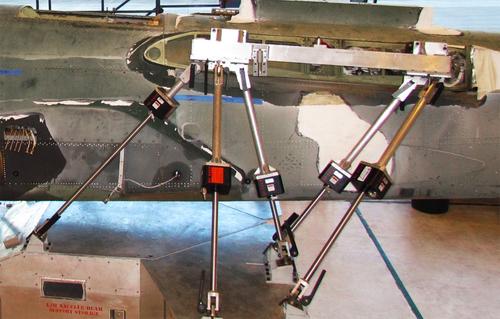Pneumatic Support Keeps the Air Force’s Warthog in the Skies
May 15, 2015

The A-10 Warthog has been flying with the US Air Force for almost 40 years. The aircraft's offensive capabilities -- ground attack and close air support -- are so formidable that it has been called the "sledgehammer of the skies."
The A-10 will fly for at least one more year, after funding for continued operations was approved by Congress on April 30. That means the refurbishment and maintenance work on the aircraft will go on, as well.

To carry out the program, at Hill Air Force Base in Utah, Boeing built five custom carriages using a custom, upgraded pneumatic rod lock system developed by Advanced Machine & Engineering Co. (AME), of Rockford, Ill.
The system is based on AME's fourth-generation AMLOK line, according to the company's sales manager, Shane Hatfield, but is customized for the five specially made Boeing fixtures, which allow the A-10's heavy fuselage to be mounted for structural repair operations without deforming the airframe. (The A-10's empty weight is 29,000 lb.) Each fixture has 28 rod locks, with each able to support 5,000 lb with little backlash.
The rod lock is a "power-off" unit, which means it only engages locking points on a cylinder rod when pneumatic power is shut off. "Release pressure and holding force go hand-in-hand," Hatfield said.


Commercial AMLOK versions use 60 psi of pneumatic power from shop air to keep the clamping mechanism open. The A-10 lock requires 90 to 95 psi. Once the lock is positioned on a rod, pneumatic pressure is shut off, activating the spring-loaded clamping mechanism. Using pneumatic pressure to deactivate the locks improves worker safety and prevents mishaps caused by accidental loss of air. Only when pressure is restored can the load be released.
The Air Force contacted Boeing, which has a facility in St. Louis and conceived the design of the fixtures and subcontracted their manufacture out to area firms, and that's when AME joined the project. Hatfield led his team in the design and delivery of the rod locks to Boeing.
MORE FROM DESIGN NEWS: Small Things Are Big in Fluid Power
Hatfield does not disclose details of the rod lock's interior design, saying only that it is a "complicated mechanism" with a "piston and collet configuration" and "a lot of technology." Features include a static wipe rod that cleans the grooves in the rod cylinders where the lock attaches.
Supporting 5,000 lb, each A-10 rod lock handles almost double the load of a conventional lock and maintains its position with maximum axial backlash of 0.002 to 0.003 inches. Hatfield says some level of "float" is needed in lock attachments because components would drag on each other and affect locking integrity. Axial backlash measurements were tracked by laser during prototype testing of the fixtures and locks.
MORE FROM DESIGN NEWS: Driving Efficiency With Hydraulic & Pneumatic Systems
Boeing manufactured five fixtures for the refurbishment program. Each has 28 holding points for locks. Rod locks are positioned at seven points on both sides of the fuselage -- 28 points in all. This means that AME supplied at least 140 locks for the fixtures.
Hatfield says the company's commercial locks are tested for 2.5 to 7 million cycles and warranted for one year and 1 million cycles. The comparatively low number of A-10 refurbishments (the entire fleet is about 265 aircraft) means each lock may only experience 200 cycles per year.
But this was a case where the size and weight of the aircraft required a custom system that was beyond standard catalog rod locks.
Pat Toensmeier has more than 30 years of experience writing for business-to-business publications. His main areas of coverage have been defense, design, manufacturing, technology and chemicals, especially plastics and composites. He has reported extensively on developments in these areas from the U.S. and Europe, and covered industry events as well in Brazil and Asia. Toensmeier has held various positions at major publishers such as the McGraw-Hill Companies and Hearst Corporation. A graduate of the University of Missouri, he is a contributing editor for several print and online publications. Toensmeier is based in suburban New Haven, Conn.
Atlantic Design & Manufacturing, the largest advanced design and manufacturing trade show serving the Northeastern US, will take place in New York, June 9-11, 2015. It's your chance to meet qualified suppliers, get hands-on with the latest technologies, and expand your network. Learn more here.
About the Author(s)
You May Also Like





